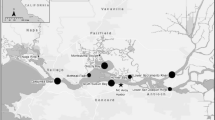Abstract
This study evaluated the physiological condition and environmental contaminant concentrations in muskrats inhabiting the contaminated lower region of the Elizabeth River, Virginia, (USA). Muskrats trapped in the lower region of the Elizabeth River weighed less, had lower mean fat indexes, lower relative spleen weights, greater relative adrenal weights, and an increased incidence of disease and parasitism compared to muskrats trapped in the less contaminated upper region of the Elizabeth River or Nansemond River. Concentrations of the metals aluminum, cadmium, copper, nickel, and zinc and the number of polyaromatic hydrocarbon compounds were greater in lower Elizabeth River muskrats compared to upper region Elizabeth River or Nansemond River muskrats. These physiological data indicated that muskrats in the lower region of the Elizabeth River were in poor health relative to muskrats from the other regions studied. However, no significant difference in fecundity or density was observed among regions studied, suggesting that the level of environmental contaminant exposure was not sufficient to elicit a population level response. Greater population declines following severe natural environmental stresses (large storms, extreme cold, etc.) would be anticipated in lower region Elizabeth River muskrats; however, the muskrat population in this region does not now appear to be at risk of extirpation.
Similar content being viewed by others
References
Baumgartner LL, Bellrose FC (1943) Determination of sex and age in muskrats. J Wildl Manage 7:77–81
Bieri RH, Hein C, Huggett RJ, Shou P, Slone H, Smith C, Su CW (1986) Polycyclic aromatic hydrocarbons in surface sediments from the Elizabeth River subestuary. Int J Environ Anal Chem 26:97–113
Byrd MA (1953) High occurrence of Taenia taeniaeformis in the muskrat (Ondatra z. zibethica). J Wildl Manage 17:384–385
Cerco CF, Kuo AY (1981) Real-time water quality model of the Elizabeth River system. Special report no. 215 in applied marine science and ocean engineering. Virginia Institute of Marine Science, Gloucester Point, VA
Dunn BP, Black JJ, Maccubbin A (1987) 32P-Postlabeling analysis of aromatic DNA adducts in fish from polluted areas. Cancer Res 47:6543–6548
Dunn BP, San RHC (1988) HPLC enrichment of hydrophobic DNA-carcinogen adducts for enhanced sensitivity of 32P-Postlabeling analysis. Carcinogenesis 9:1055–1060
Erickson DW (1977) Spatial variation of pollutants and muskrats (Ondatra zibethica) of different pollution zones, Tinicum National Environmental Center, Pennsylvania. MS Thesis, Pennsylvania State Univ, University Park
Erickson DW, Lindzey JS (1983) Lead and cadmium in muskrat and cattail tissues. J Wildl Manage 47:550–555
Errington PL (1963) Muskrat populations. Iowa State University Press, Ames, Iowa
Everett JJ, Anthony RG (1976) Heavy metal accumulation in muskrats in relation to water quality. Proc Northeast Fish Wildl Conf 33:105–116
Goyer RA (1986) Toxic effects of metals. In: Klaassen CD, Amdur MO, Doull J (eds) Cassarett and Doull's Toxicology: The basic science of poisons. Macmillan NY, pp 582–635
Gupta RC, Reddy MV, Randerath K (1982) 32P-postlabeling analysis of nonradioactive aromatic carcinogen: DNA adducts. Carcinogenesis 3:1081–1092
Halbrook RS (1990) Muskrat populations in Virginia's Elizabeth River: Influence of environmental contaminants. PhD thesis, Virginia Polytechnic Institute and State University, Blacksburg, VA
Halbrook RS, Kirkpatrick RL (1990) Use of barbiturate-induced sleeping time as an indicator of exposure to environmental contaminants in the wild. In: McCarthy JF, Shugart LR (eds) Biological markers of environmental contamination. Lewis Publishers Chelsea, MI, pp 151–164
Halbrook RS, Dunn BP, Bevan DR, Kirkpatrick RL (1992) DNA adducts detected in muskrats by 32P-postlabeling analysis. Environ Toxicol Chem 11:1605–1613
Hargis WJ, Roberts MH Jr, Zwerner DE (1984) Effects of contaminated sediments and sediment-exposed effluent water on an estuarine fish: Acute toxicity. Mar Environ Res 14:337–354
Huggett RJ, Bender ME, Unger MA (1987) Polynuclear aromatic hydrocarbons in the Elizabeth River, Virginia. In: Dickson KL, Makie AW, Brumgs WA (eds) Fate and effects of sediment-bound chemicals in aquatic systems. Pergamon Press, NY, pp 327–341
Lu MZ (1982) Organic compound levels in a sediment core from the Elizabeth River of Virginia. MS Thesis. College of William and Mary, Williamsburg, VA
Lundy JS (1931) Experience with sodium ethyl (1-methylbutyl) barbiturate (Nembutal) in more than 2,300 cases. Surg Clin North Am 11:909–915
Meyer MC (1950) Parasites of muskrats in Maine. Am Midl Nat 44:467–477
Neilson BJ, Sturm SC (1978) Elizabeth River water quality report. Special report No. 134 in Applied Marine Science and Ocean Engineering. Virginia Institute of Marine Science, Gloucester Point, VA
Otis DL, Burnham KP, White GC, Anderson DR (1978) Statistical inference from capture data on closed animal populations. Wildl Monogr 62
Rauch RL (1946) Parasites of Ohio muskrats. J Wildl Manage 10:70
SAS Institute, Inc. (1985) SAS user's guide: Statistics, 5th edition. SAS Institute, Inc, Cary, NC
Snead IE (1950) A family trap live trap, handling cage, and associated techniques for muskrats. J Wildl Manage 14:67–79
Sweatman GK (1952) Endoparasites of muskrats in the vicinity of Hamilton, Ontario. J Mammal 33:248–250
Vogelbein WK, Fournie JW, Van Veld PA, Huggett RJ (1990) Hepatic neoplasms in the mummichog Fundulus heteroclitus from a creosote-contaminated site. Cancer Res 50:5978–5986
Virginia Water Quality Control Board (1983) The Elizabeth River: An environmental perspective. Virginia State Water Control Board. Basic Data Bulletin No. 61
--(1984) Background and problem assessment report for the Elizabeth River. Virginia State Water Control Board. Information Bulletin 557
Wilson KA (1954) Litter production of coastal North Carolina muskrats. Proc Southeast Assoc Game Fish Comm 8:13–19
Author information
Authors and Affiliations
Rights and permissions
About this article
Cite this article
Halbrook, R.S., Kirkpatrick, R.L., Scanlon, P.F. et al. Muskrat populations in Virginia's Elizabeth River: Physiological condition and accumulation of environmental contaminants. Arch. Environ. Contam. Toxicol. 25, 438–445 (1993). https://doi.org/10.1007/BF00214332
Received:
Revised:
Issue Date:
DOI: https://doi.org/10.1007/BF00214332




